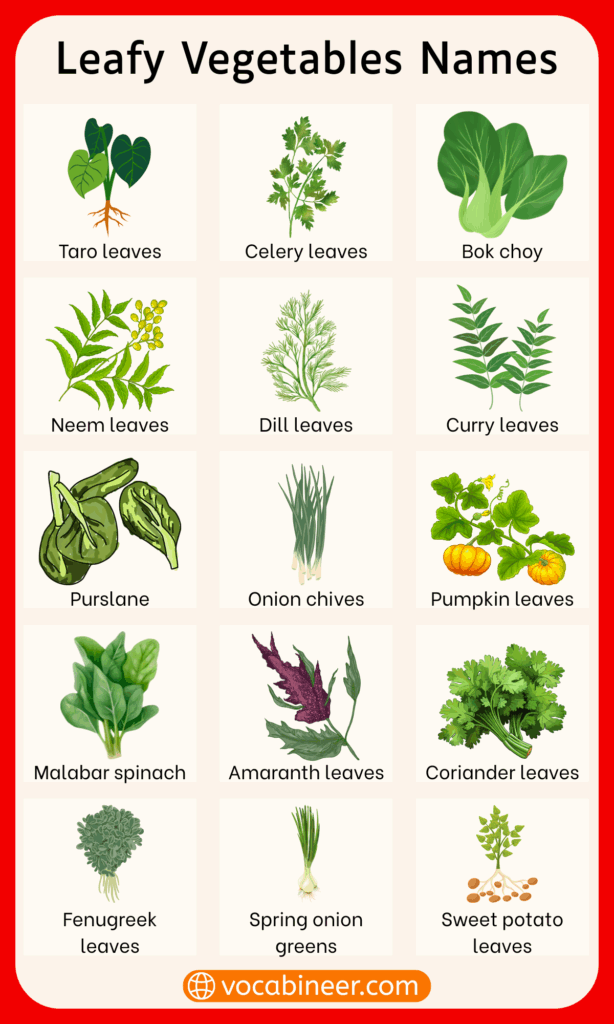Learning leafy vegetables names in English helps students grow their vocabulary for food, health, and daily life. These vegetables are green and soft, and we use them in cooking, salads, and soups. By looking at pictures and names together, it becomes easier to remember each one. You’ll see words like spinach, lettuce, and cabbage, along with other greens used in many dishes. This topic also helps with spelling, word groups, and better understanding of healthy foods.
In This Page
List of Leafy Vegetables Names in English for Beginners
These are the most familiar leafy vegetables students often see in kitchens, markets, or textbooks:
- Spinach
- Lettuce
- Cabbage
- Coriander leaves
- Mint leaves
- Fenugreek leaves (Methi)
- Mustard greens
- Spring onion greens
- Kale
- Collard greens
- Swiss chard
- Arugula (Rocket)
- Parsley
- Basil
- Watercress
- Bok choy
- Amaranth leaves
- Sorrel leaves
- Dill leaves
- Beet greens
- Turnip greens
- Radish leaves
- Malabar spinach
- Curry leaves
- Drumstick leaves (Moringa)
- Taro leaves
- Neem leaves
- Pumpkin leaves
- Sissoo spinach
- Iceberg lettuce
- Romaine lettuce
- Red leaf lettuce
- Napa cabbage
- Savoy cabbage
- Chinese cabbage
- Patra leaves
- Celery leaves
- Chives
- Endive
- Dandelion greens

Common Green Leafy Vegetables with Pictures
This group includes greens found across different countries and used daily in homes:
- Spinach – soft, dark green leaves used in many dishes
- Lettuce – light green leaves often used in sandwiches and burgers
- Cabbage – round vegetable with layers of thick leaves
- Coriander leaves – fresh herb used for garnishing food
- Mint leaves – small green leaves with a cool, fresh smell
- Mustard greens – slightly spicy leaves popular in Indian dishes
- Fenugreek leaves (Methi) – tiny leaves used in cooking and parathas
- Spring onions – green stalks used in salads and soups
Names of Leafy Vegetables Used in Cooking and Salads
These leaves add color, texture, and nutrition to meals:
- Lettuce – adds crunch to sandwiches and burgers
- Spinach – used in saag, soups, and pasta
- Coriander leaves – sprinkled on top of curries
- Mint – used in chutneys, raita, and drinks
- Parsley – a mild herb used as garnish
- Basil – sweet leaves used in Italian and Thai food
- Sorrel leaves – tangy taste, used in stews and soups
Popular Green Leafy Vegetables to Learn
These leafy vegetables are important for food and language learning:
- Amaranth leaves – known as “chaulai,” used in many South Asian dishes
- Dill leaves – called “suva,” used for flavor and aroma
- Radish leaves – often used in parathas and stir-fries
- Turnip greens – mildly bitter leaves used in cooking
- Beet greens – the leafy part of the beetroot plant
- Pumpkin leaves – soft leaves used in traditional recipes
Indian and Asian Leafy Vegetables in English
These leaves are common in Indian, Pakistani, and Asian cooking styles:
- Bathua (Chenopodium) – used in saag and parathas
- Malabar spinach (Poi saag) – soft, thick green leaves
- Curry leaves – used for flavor in tadka and curries
- Taro leaves (Arbi ke patte) – used in “patra” and other recipes
- Neem leaves – bitter, sometimes used in Ayurvedic food
- Sissoo spinach (Poi patta) – climbing leafy vegetable
- Drumstick leaves (Moringa) – superfood leaves packed with nutrients
Seasonal Leafy Vegetables to Learn by Name
Some greens grow in specific seasons, helping learners connect time with vocabulary:
Winter leafy vegetables:
- Mustard greens
- Bathua
- Fenugreek
- Spinach
Summer leafy vegetables:
- Malabar spinach
- Mint leaves
- Amaranth leaves
- Pumpkin leaves
Year-round leafy vegetables:
- Lettuce
- Coriander leaves
- Cabbage
Leafy Vegetables with High Nutritional Value
These greens are rich in vitamins, minerals, and fiber — helpful for healthy vocabulary learning:
- Spinach – high in iron and vitamin K
- Kale – full of calcium and antioxidants
- Moringa leaves – packed with protein and nutrients
- Swiss chard – rich in magnesium and fiber
- Fenugreek leaves – good for digestion
- Mustard greens – contain vitamin C and folate
- Collard greens – provide vitamin A and potassium
FAQs about Leafy Vegetables Names
Spinach is one of the most widely used and taught leafy vegetables.
Mustard greens, fenugreek, coriander, and curry leaves are common in Indian cooking.
Most are green, but some, like red lettuce and Swiss chard, have purple or red tints.
Herbs like mint and parsley are mainly for flavor; leafy vegetables like spinach and cabbage are used in larger amounts for nutrition and bulk in meals.
Read More




